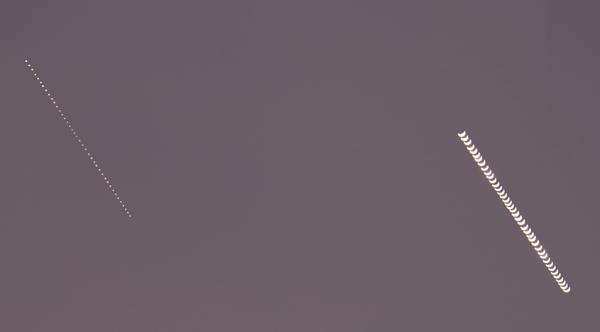This page describes an image Venus and Mercury Trails
Image caption:
In this composite image, both Mercury (left) and Venus (right) can be seen heading into the sunset. The phases of each are beautifully captured as they descend. Not all planets or moons in the Solar System show phases as viewed from Earth. This phenomenon occurs because the orbits of Venus and Mercury are positioned between Earth’s orbit and the Sun, sometimes allowing us to see only part of the illuminated portion of each planet. These phases are similar to the phases we see of our own Moon.
Scroll to captions in other languages
Image credit:
Marcella Giulia Pace (CC BY 4.0)
DOI: 10.5281/zenodo.10359166
Tags:
astrophotography
Related glossary terms:
Mercury
, Phase
, Venus
Categories:
Solar System
Image license: Creative Commons Attribution 4.0 International (CC BY 4.0) Creative Commons Attribution 4.0 International (CC BY 4.0) icons
The media file captions presented on the OAE website were written, translated and reviewed by a collective effort from the OAE, the OAE Centers and Nodes, the OAE National Astronomy Education Coordinators (NAECs) and other volunteers. You can find a full list of credits for our translation project here. All media file captions are released under a Creative Commons CC BY-4.0 license and should be credited to "IAU OAE". The media files themselves may have different licenses (see above) and should be credited as listed above under "credit".
Captions in Different Languages:
Image caption: Menzione d'onore al concorso di astrofotografia IAU OAE 2023, categoria Immagini fisse di fasi di Venere: Tracce di Venere e Mercurio, di Marcella Giulia Pace.
In questa immagine composita, che riceve una menzione d'onore nella categoria Immagini fisse di fasi di Venere, si vedono sia Mercurio (a sinistra) che Venere (a destra) dirigersi verso il tramonto. Le fasi di ciascuno sono splendidamente catturate mentre scendono. Non tutti i pianeti o le lune del sistema solare mostrano le fasi viste dalla Terra. Questo fenomeno si verifica perché le orbite di Venere e Mercurio sono posizionate tra l'orbita della Terra e quella del Sole, consentendoci talvolta di vedere solo una parte della porzione illuminata di ciascun pianeta. Queste fasi sono simili a quelle che vediamo sulla nostra Luna.
Image credit: Marcella Giulia Pace (CC BY 4.0)
Related glossary terms: Fase , Mercurio , Venere (pianeta) Caption translation status: Not yet approved by a reviewer
Caption translators: Valentina La Parola
Image caption: 在这张合成图中,可以看到水星(左)和金星(右)都在向日落进发。水星和金星降落时的相位都被捕捉到了,非常漂亮。从地球上看,太阳系中并非所有行星或卫星都会出现相位。出现这种现象是因为金星和水星的轨道位于地球轨道和太阳之间,有时我们只能看到每颗行星某一部分受到光照。它们的相位与我们看到的月球相位相似。
Image credit: 玛塞拉-朱利亚-佩斯 (CC BY 4.0)
Related glossary terms: Mercury , Phase , 金星 Caption translation status: Not yet approved by a reviewer
Caption translators: Lin Shijie
Image caption: 在這張合成圖中,可以看到水星(左)和金星(右)都在向日落進發。水星和金星降落時的相位都被捕捉到了,非常漂亮。從地球上看,太陽系中並非所有行星或衛星都會出現相位。出現這種現象是因為金星和水星的軌道位於地球軌道和太陽之間,有時我們只能看到每顆行星某一部分受到光照。它們的相位與我們看到的月球相位相似。
Image credit: 瑪塞拉-朱利亞-佩斯 (CC BY 4.0)
Related glossary terms: Mercury , Phase , 金星 Caption translation status: Not yet approved by a reviewer
Caption translators: An automated transliteration from the simplified Chinese translation by - Lin Shijie









